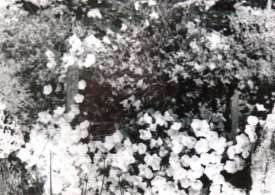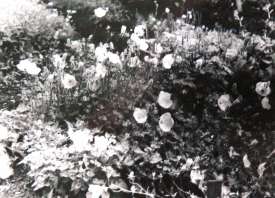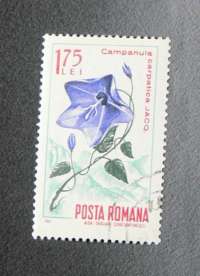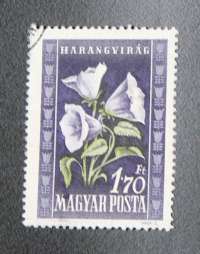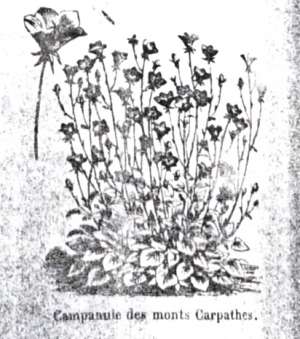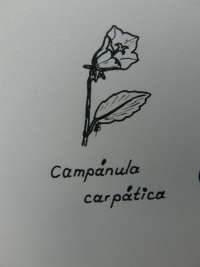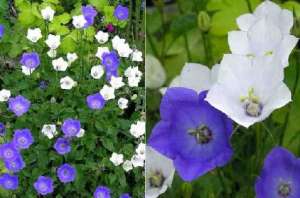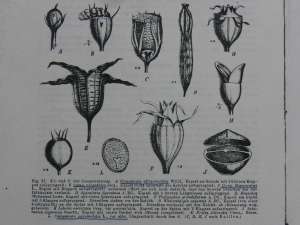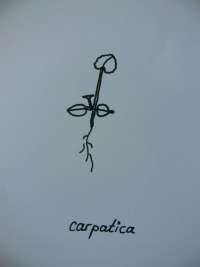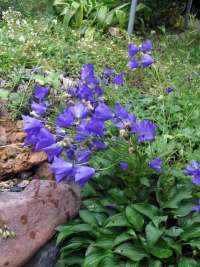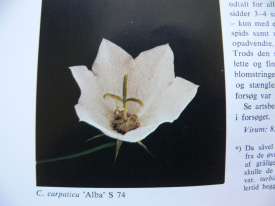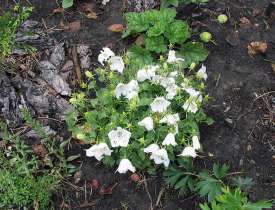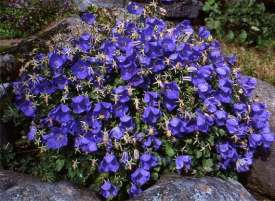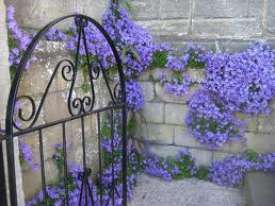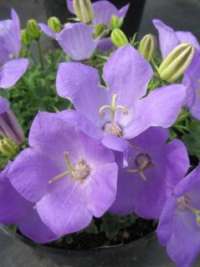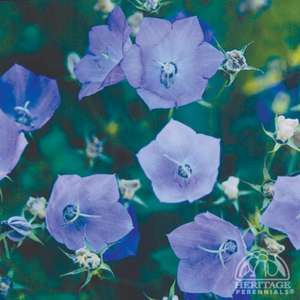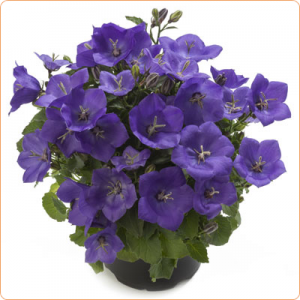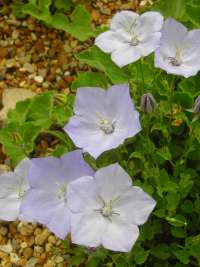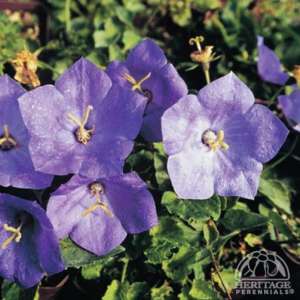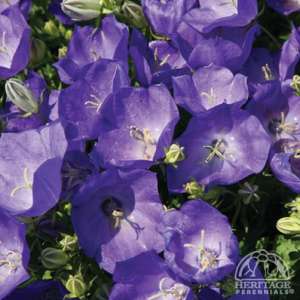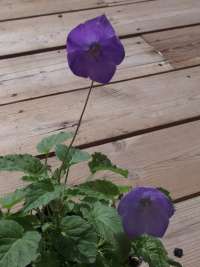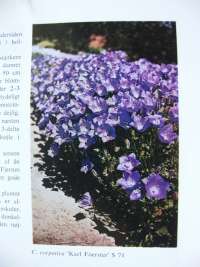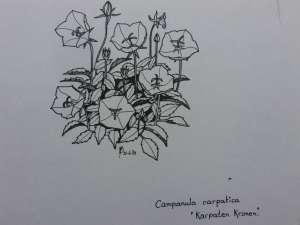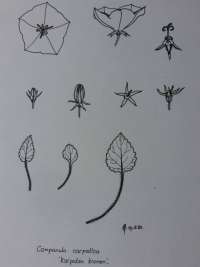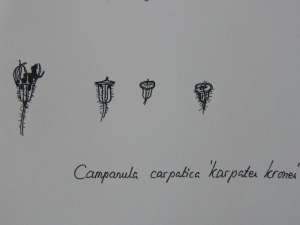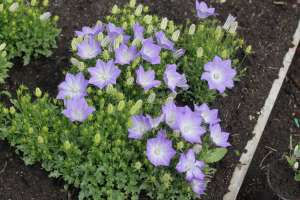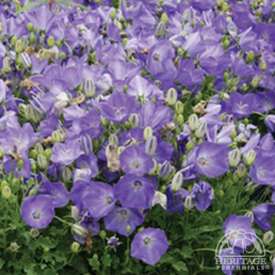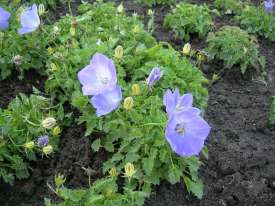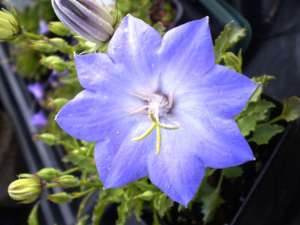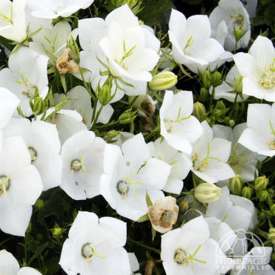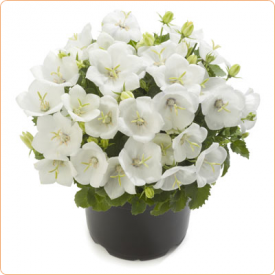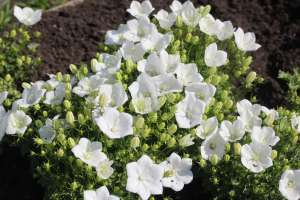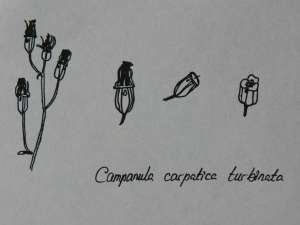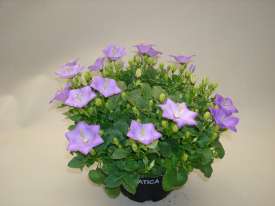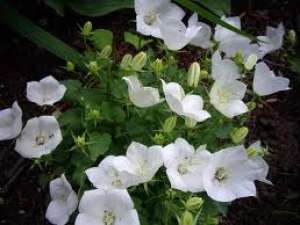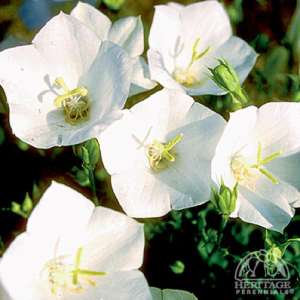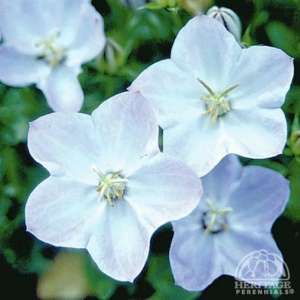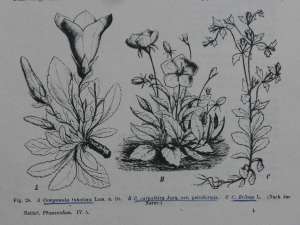Inhoud
carpatica
Campanula carpatica
Jacq.
Infrageneric Taxa
Fam. des Campanulacées. Section 2: Calice sans appendice. Groupe 1: - Capsules á 3 loges, sessiles, dressées1)
Nomenclatuur
Introduceret ca. 1774 (Crook 1951) 2).
A hybrid between Campanula carpatica and Campanula pyramidalis, but similar to Campanula carpatica, to 6 in, thought to be Campanula x Fergusonii Hort. Ex Andre 3).
Jacq. Synonym Campanula turbinate Schott. Tussock B.
Material offered as Campanula Raineri is often a dwarf form of this species. Represented in culture by many cultivars, including color variants.
Campanula carpatica x Campanula cochleariifolia is Campanula x haylodgensis Hort.
Campanula x pseudoraineri Hort. Thought to be a hybrid between Campanula carpatica and Campanula Raineri, but differs from the former only in its slightly grayer foliage 4).
Campanula X pulloides Hort. Reported to be a hybrid between Campanula carpatica and Campanula pulla; plants to 8 in.; corolla blue-purple, very large and broad.
Campanula x Stansfeldii Hort. Apparently a hybrid, Campanula carpatica x Campanula Waldsteiniana. 5).
Campanula carpatica x Campanula lusitanica = ? annual progeny
Campanula carpatica Jacq. = Campanula cordifolia Vuk. = Neocodon carpaticus (Jacq.) Kolak. & Serdyuk.6)
Campanula carpatica x Campanula isophylla alba = Campanula carpatica Hybrid Riverslea.7)
Names
NL.: Karpaten klokje
E.: Carpathian Bellflower Fr.: Campanule des monts Carpathes, Campanule á feuilles en coeurHabitus
The erect flowers are born on branching stems, generally at a hight of 10 to 15 inches. The white variety is equally good.8) - Vivace. - Plante glabre, toufflue. Tiges gréles, dressées ou étalées, rameuses,élevées de 20 á 30 centrimétres. Feuilles ovales-arrondies, crenelées-dentées. Fleurs terminales, en cloche évasée et dressée; calice á divisions linéares-aigués, longues de 15 millimétres; corolle bleue, au moins trois fois plus longue que le calice.9).
Altezza: cm. 30. Pianta perenne e rustica, a portamento molto compatto, nana, a steli sottili ed cretti, contendenza a espandersi.10)
Glabrous, clump-forming perennial, 8-18 in. Stems slender, spreading, leafy at base. Tot 38 cm, bloeit april-september. Proef uit 1967.11) Perennial plant with thin, leafy stems up to 30 cm tall. Growth bushy, growing shoots. Bush up to 30 cm in diameter. Basal leaves on long stalks, ovate-rounded, gathered in dense rosette; stem - on short stalks, ovate. Flowers solitary, infundibular-campanulate, white, blue, purple, up to 5 cm in diameter. 12)
Anatomisch
Bei einer Anzahl Arten von Campanula und bei einigen Arten nahe verwandter Gattungen (Michauxia, Phyteuma, Symphyandra, Specularia) kommen Abweichungen vom typischen Bau der Stengel (auch hier und da der Wurzeln) vor, die eine besondere Erwahnung verdienen. Es sei jedoch von vornherein bemerkt, dass dieselben nicht immer bei allen Individuen derselben Art die gleichen sind. In den einfachsten Fallen finden sich innerhalb des Holzringes Gruppen von kleinzelligem, teilingsfahigem Gewebe, dem Siebrohren fehlen (Campanula persicifolia L., Campanula carpathica Jacq., Campanula attica Boiss.) Siebrohren finden sich bei Campanula latifolia L., Campanula Trachelium L. Dieselben besitzen also inneren Weichbast. Bei Campanula Grossekii Heuff. sind einige dieser Weichbastbundel auf der ausseren, also der dem primaren Holze zugekehrten Seite mit radial angeordneten Holzzellen versehen. Von hier aus finden sich nun alle moglichen Ubergange bis zur Ausbildung eines oder mehrerer Ringe von getrennten collateralen oder auch concentrischen Gefassbundeln (letztere mit centralem Phloem), und schliesslich kann es dazu kommen, dass diese Bundelmit einander verschmelzen und so einen geschlossenen, inneren Gefassbundelring bilden (z.B. Campanula pyramidalis L.). Die inneren Gefassbundel haben ubrigens meist Dickenwachstum, mogen sie getrennt oder vereinigt sein.
Nach Westmaier ist das Vorkommen innerer Strange nie zu beobachten bei jenen Arten der Gattung Campanula, welche bei geringer Hohe armblutig sind. Dieser Satz darf nicht umgekehrt werden, z.B. sind die stattlichen und reichblutigen Campanula rapunculoides L. und Campanula Medium L. ganz normal gebaut. Weiss hat ubrigens nachgewiesen, dass die markstandigen Bundel nicht stammeigen sind. Derselbe hat auch bei Campanula pyramidalis L. Rindenbundel (mit centralem Xylem und Dickeuwachstum) beobachtet. (Nahares bei Westermaier, Monatsber. der Kgl. Akademie der Wissenschaften, Berlin 1881, p.1064; Petersen in Engler's Jahrbuchern III, 1882, p. 394; Weiss, in Bot. Centralblatt XV, 1883, p. 325). G. Kraus hat bei 12 Gattungen - gemass der im Folgenden angenommenen Umgrenzung - das Vorkommen von Inulin nachgewiesen (Bot. Zeitung 1877, p. 329), nachdem Prantl es zuerst bei Campanula rapunculoides aufgefunden hatte.13)
Leaves
Le foglie sono ovali, arrotondate alla base, crenate.14)
Leaves long-petioled, ovate-triangular to broadly lanceolate, 2 in. long or less, deeply serrate, long-petioled. Basal leaves on long stalks, ovate-rounded, gathered in dense rosette; stem - on short stalks, ovate. 15)Flowers
Fioritura: V-VII. I fiori, azzurri, sono terminali, a campana aperta: tra le Campanula nane e una di quelle a fiori piu grandi.16)
Flower measuring, between 25 - 40mm (1 - 1 1/2 inch.). Campanula carpatica hybrids or varieties between 40 - 50mm (1 1/2 - 2 in.)17) Flowers erect on long, slender, naked, axillary pedicels, calyx without appendages, corolla blue-lilac, 1-2 in. across, broadly campanulate, style exserted. Blumen einzeln, endstandig oder in wenigblutigen Trauben mit absteigender Entfaltung. Fig 27 B, 28 B.18)Flowers solitary, infundibular-campanulate, white, blue, purple, up to 5 cm in diameter. It flowers from June 60-70 days.19)
Chromosomes
Number of diploid chromosomes (2n=34).
Fruit
Kapsel nahe der Spitze, seltener etwas oberhalb der Mitte sich offnend, 3facherig. Kelchbuchten ohne Anhangen. Sect. II Rapunculus Boiss.20)
Seed available, in small quantity. Species actually grown or used for breeding 21) Fruit - oval-cylindrical, bare box. Seeds ripen in July and August. 22) C. carpatica JACQ.. :Orig 016138-0344-78 Locn 1A EU, geo: 40000, rec: SEED, lab: 1, dis: E.EUROPE,CARPATHIANS ayr: 7823) Campanula carpatica Jacq. 1139-79 De: Botanischer Garten, Berlin - Dahlem, Allemagne. 2-4-79 Descr.: sem. 1. Couche fr. 9, s-29, 1 t.s.- 16-8-79; 2. couche fr. 8, S-15, 14 - 28-7-80; couche fr. 8, S-25, 13 - 28-7-80; 3. jard.omb., M-1 - 28-1-82.24)
Germination
Hybrid
Campanula carpatica Jacq.cv. Basket 842-64 De: Sutton, Raading, England. 3-64. Descr.: sem., 1 pgt. 13. Serre 1, 1 panier 25-1-7725)
- Campanula carpatica cv. 'Blue Clips'- hyb. - open and hand Pollination26)
USDA Zone: 2-9. Plant number: 1.110.100. (='Blaue Clips') One of the most popular Bellflowers. Plants form a low, cushion-shaped mound of small green leaves, with loads of upfacing, open bells appearing in early summer. This selection has flowers in a clear medium-blue shade. Will continue blooming for weeks if spent blossoms are regularly removed. Excellent choice for the rock garden, edging and in containers. Performs especially well in regions with cool nights during the summer. Plants should be divided every 2 to 4 years, in spring or fall. Prefers good drainage. Sun Exposure; Full Sun or Partial Shade. Soil Type; Normal or Sandy or Clay. Soil pH; Neutral or Alkaline or Acid. Soil Moisture; Average or Dry or Moist. Care Level; Easy. Flower Colour; Deep Blue. Blooming Time; Early Summer, Mid Summer, Late Summer. Early Fall; Foliage Color; Light Green. Plant Uses & Characteristics; Accent: Good Texture/Form, Alpine & Rock, Border, Containers, Drought Tolerant, Edging, Rabbit Resistant, Massed. Flower Head Size; Small. Height; 15-30 cm, 6-12 inches, Spread; 20-30 cm, 8-12 inches. Foot Traffic; None. Growth Rate; Medium.27) Campanula carpatica Jacq. cv. 'Karpaten Krone' 1941-76. De: Zoo and Bot. Gard., Rotterdam, Holland, 7-4-76. Descr.: sem. Arr.: Campanula hybrida 'Karpaten Krone'28)
- Campanula carpatica cv. Riverslea
1942-76. De: Zoo and Bot. Gard., Rotterdam, Holland, 7-4-76. Descr.: sem. Arr.: Campanula hybrida 'Riverslea'. 5.) Couche 68, 1,5 r. 16-7-80; 6.) couche 68, 4. 29-6-81; 7.) couche 68, 4. 30-7-8229)
A large-flowered spontaneous hybrid, raised from seed saved from a curious form found at Eastbourne by the late Mr. Robert Parker. The reputed parents, he told me, were carpatica x isophylla alba, and the wide, open somewhat flattened salver-shaped blue corollas may perhaps be traced to the influence of isophylla.30)
- Campanula carpatica hybr. 'Samantha'31)
Cultivars
- Campanula carpatica cv. 'Alba' 33)
Campanula x Jenkinsae Hort. Presumed to be a hybrid between Campanula carpatica cv ‘Alba’ and Campanula rotundifolia. 34).
The very light green and slightly haired basal-leaves form a cushion which in the second year is 65cm broad and 22-25cm high. A very rich flowering plant, during the flowering time about 50cm high. If the weather is rainy and windy during the flowerinr, the stems will overturn which is more or less common to all Campanula carpatica-cultivars.
The flowers are sitting 3-4 togerther, they are white and with a yellowish touch on the apix of the corolla and on the flowerbuds. The campanulate flowers are upright, 3cm long and 5cm wide. In spite of the abundance of flowers the appearence is light and fine. The flower-stalks have to be cutt off after flowering to get best impression of the plants. The plants remount only slightly. All plants in both trials were hardy35) .
Since both 'Alba' and 'Karl Foerster' are separating from the other C. carpatica by having greyish hair and bigger flowers they ought to be referred to C. carpatica var. turbinata. In the danish nurseries both of the varieties are called C. carpatica36)
Campanula carpatica Jacq. Alba 1470-73 De: Sheridan Nurseries Ltd., Montée Liesse, Montreal 15-5-73. Descr.: 45 plts. 1). Jard/ pl. viv., A-1, 44 - 11-6-73; 2) jard. pl. viv., A-1, 44 - 2-7-74; 3). jard. pl. viv., Q-3, 14 - 27-5-75; 4). jard. pl. viv., R-3, 14 - 17-6-76; 5). jard. pl. viv., R-3, 14 - 8-7-77; 6). jardin pl. vivaces, R-3, 14 - 18-5-78; 7). jardin pl. vivaces, R-3, 14 - 10-5-79; 8). jard. pl. viv., R-3, 14 - 23-5-80; 9). jard. pl. viv., R-3, 17 - 5-6-81; 10). jard. viv., R-3, 17 - 8-6-82.37)
- Campanula carpatica cv. 'Basket' 842-64
Arr.: Campanula hybr. 'Basket', De: Sutton, Rading, England. 3-64. Descr.: sem., 1 pgt. 13. Serre 1, 1 panier. 25-1-77.38)
- Campanula carpatica cv. 'Blauer Zwerg'
(Bruske) 39). Bellflower Series “Clip” - a charming low plant with thin delicate stalks, only 20 cm high. The flowers are large, up to 5 cm in diameter. Liberally blooms almost all summer, starting in June. Ideal for borders, rockeries and foreground mixborders. Excellent pot plant. It grows in the sun and in partial shade, hardy. In 1 g of seed 13000-15000. Seeds germinate in light 14-30 days at + 18-22 ° C. The soil is loose, well-drained, alkaline, moderately fertile. Bloom 20 weeks after sowing. This bell is grown in full sun with loose loamy soil. With a lack of moisture reduces the duration of flowering, but the plant moist soils in winter falls. Watering is required only during prolonged heat. If the plant falls to its neighbors - is a sign of excess moisture. After flowering, the inflorescence is cut. Propagation seedling method, sowing in the greenhouse in April. Seedlings grow very slowly, they have to dive twice and were grown on the ridge. Flowering starts mostly only in the third year. Mature plants are unpretentious in culture. They bloom from June to September, the autumn require pruning. At one place can grow to six. Older plants divide is very difficult. Good partners are Geranum dalmaticum and Helianthemum hybriden.40)
- Campanula carpatica cv. 'Blaue Clips'
Synonym: Campanula carpatica cv. 'Blue Clips', Campanula carpatica cv. 'Blue Chips'41) Probably 'Blue Clip' also 'Clips deepblue' from Beekenkamp Plants BV.
Beekenkamp Plants BV- Ornamentals is breeder and propagator of home and garden plants.
The flower color is blue and the flowering period is from about June to August. The leaves are green and about 10 cm. high. The mature height of this perennial is about 20 cm. Withstands temperatures up to -35 gr. C. The recommended planting distance is 30 cm. (8-11 pcs. Per m2.)42)
Seed available, in small quantity. Species actually grown or used for breeding 43) (Wagner/Benary 1967) 44).- Campanula carpatica cv. Blaumeyze
*Campanula carpatica cv. Blue Moonlight
* Campanula carpatica cv. ‘Blue Uniform’
USDA Zone: 2-9. Plant number: 1.110.110. Carpathian Bellflowers are extremely popular for edging or growing in the sunny rock garden. Plants form low cushion-shaped mounds of small green leaves, with loads of upfacing bell-shaped blooms beginning in early summer. This selection has flowers of medium lavender blue. Remove spent flowers to encourage more buds to form. Clumps may be easily divided in early to mid spring if desired. In hot, humid summer regions these are seldom long lived. Further details for Optimal Growing Conditions Appearance and Characteristics. Sun Exposure; Full Sun or Partial Shade. Soil Type; Normal or Sandy or Clay. Soil pH; Neutral or Alkaline or Acid. Soil Moisture; Average or Dry or Moist. Care Level; Easy. Flower Colour; Deep Blue. Blooming Time; Early Summer, Mid Summer, Late Summer. Early Fall. Foliage Color; Light Green. Plant Uses & Characteristics; Accent: Good. Texture/Form; Alpine & Rock, Border, Containers, Drought Tolerant, Edging, Rabbit Resistant, Massed Flower, Head Size Small, Height 20-25 cm, 8-10 inches. Spread 20-30 cm, 8-12 inches. Foot Traffic; None. Growth Rate Medium.46)
- Campanula carpatica cv. Chenton Joy
- Campanula carpatica cv. 'Chewton Joy'
Seed available, in small quantity. Species actually grown or used for breeding 48)
- Campanula carpatica cv. ‘China Doll’
Supplement to the Annual Seedlist, 1983, Volume 3,1, Others, nr. 430: Campanula carpatica cv. China Doll / W. Lahmann - bluish-mauve 49)
Campanula carpatica Jacq.cv. Clips Blanc 1006-70 De: Gr. d'élite Clause, Bretigny-sur-orge 91, France. Descr.: sem., 1.) Couche fr. 9, 1 boíte 28-9-70, 2.) couche 113, 45 6-7-71, 3.) couche 113, 41 13-7-72, 4.) couche 113, 14 19-6-73.50)
Campanula carpatica Jacq.cv. Clips Bleu 1005-70 De: Gr. d'élite Clause, Bretigny-sur-orge 91, France. Descr.: sem., 1.) Couche fr. 9, 1 boíte 28-9-70, 2.) couche 113, 15 6-7-71, 3.) couche 113, 7 11-7-72, 4.) couche 113, 16 19-6-73, 5.) couche 113, 12 2-7-74, 6.) couche 126, 8 26-6-75, 7.) couche 125, 3 19-7-76.51)- Campanula carpatica cv. ‘Compacta’
* Campanula carpatica cv. ‘Deep Blue Clips’
USDA Zone: 2-9. Plant number: 1.110.090. One of the most popular Bellflowers. Plants form a low, cushion-shaped mound of small green leaves, with loads of upfacing, open bells appearing in early summer. This selection has flowers in a clear deep-blue shade. Will continue blooming for weeks if spent blossoms are regularly removed. Excellent choice for the rock garden, edging and in containers. Performs especially well in regions with cool nights during the summer. Plants should be divided every 2 to 4 years, in spring or fall. Prefers good drainage. Sun Exposure; Full Sun or Partial Shade. Soil Type; Normal or Sandy or Clay. Soil pH; Neutral or Alkaline or Acid. Soil Moisture; Average or Dry or Moist. Care Level; Easy. Flower Colour; Deep Blue. Blooming Time; Early Summer, Mid Summer, Late Summer. Early Fall. Foliage Color; Light Green. Plant Uses & Characteristics. Accent: Good Texture/Form, Alpine & Rock, Border, Containers, Drought Tolerant, Edging, Rabbit Resistant, Flower Head Size; Small. Height; 15-20 cm, 6-8 inches. Spread, 20-30 cm, 8-12 inches. Foot Traffic; None Growth. Rate Medium.52)
Campanula carpatica Jacq.cv. Erfurter Zwerg 1774-77. De: Jard. Bot. et Arb., Brno, Tchec. 5-4-77. Descr.: sem.53)
Campanula carpatica Jacq.cv. Glacier Blue 2668-82. De: Les Floralies 1980, Section Commerciale, W.H. Perron. 19-8-82. Descr.: 1 plt.54)
- Campanula carpatica cv. 'Isabel' (Prichard) 55).
2390-77. De: Inst. de Med. si Farm., Tirgu-Mures, Roumanie, 13-5-77. Descr.: sem.57)
Fiori viola.
Seed available, in small quantity. Species actually grown or used for breeding 58)- Campanula carpatica cv. 'Jewel'
(Waterer 1938) 59).
- Campanula carpatica cv. 'Karl Foerster' 60)
Since both 'Alba' and 'Karl Foerster' are separating from the other C. carpatica by having greyish hair and bigger flowers they ought to be referred to C. carpatica var. turbinata. In the danish nurseries both of the varieties are called C. carpatica61).
Breeder: Karl Foerster. The basal-leaves are slightly haired on the surface and stronger beneath. They form an arch or nearly circleround cushion. In the second year the diameter is 50cm and the high 20-25cm.
Flowering from middle of June to late July and then they are 40-50cm high. There are 2-3 flowers on each stem, upright and with an open cup, distinct 5-lobed, 3cm long and 5cm wide. The flowering is abundant and uniform and excellent when the sun is shining. Colour: RHS 88 C, light volet, on the inner side slighter violet to nearly white and with the fine greenish-yellow 3-parted stigma on a nearly translucent style.
There is no leaf to be seen during flowering because of the abundance. Later when the stems with the unpleasant capsules are too heavy the cushing will split up. If the stems are removed, the cushion will sonn get back in shape. The plants have the light violet colour. This colour of 'Karl Foerster' is common too in the Danish nurseries. The variety is described in the German catalogues as being deep dark violet: Tief dunkelviolet, or dark violet: Dunkelviolet, but without statement of colourcode62) .
Since both 'Alba' and 'Karl Foerster' are separating from the other C. carpatica by having greyish hair and bigger flowers they ought to be referred to C. carpatica var. turbinata. In the danish nurseries both of the varieties are called C. carpatica63) .- Campanula carpatica cv. 'Karpaten Kronen'
- Campanula carpatica cv. Karpatenkrone- with purple flowers.64)
1941-76. De: Zoo and Bot. Gard., Rotterdam, Holland, 7-4-76. Descr.: sem. Arr.: Campanula hybrida 'Karpaten Krone'65)
- Campanula carpatica cv. 'Kobaltschale'
(Klose 1963) 66).
- Campanula carpatica cv. 'Lazurblauer Zwerg'
(Bruske) 67).
- Campanula carpatica cv. 'Light Blue Clips'68)
- Campanula carpatica cv. 'Mixed hybrids'69)
- Campanula carpatica cv. ‘Nana’
Supplement to the Annual Seedlist, 1983, Volume 3,1, Others, nr. 431: Campanula carpatica cv. Nana / AR - Low foliage 70)
- Campanula carpatica cv. ‘Nana alba’
* Campanula carpatica cv. ‘Pearl Deep Blue’
USDA Zone: 2-9. Plant number: 1.110.070. An improvement on the older ‘Clips’ series with larger blooms. This forms a low, cushion-shaped mound of small green leaves, with loads of upfacing, open bells appearing in early summer. This selection has flowers in a clear medium-blue shade. Will continue blooming for weeks if spent blossoms are regularly removed. Excellent choice for the rock garden, edging and in containers. Performs especially well in regions with cool nights during the summer. Plants should be divided every 2 to 4 years, in spring or fall. Prefers good drainage. Optimal Growing Conditions Appearance and Characteristics. Sun Exposure; Full Sun or Partial Shade. Soil Type; Normal or Sandy or Clay. Soil pH; Neutral or Alkaline or Acid. Soil Moisture; Average or Dry or Moist. Care Level; Easy. Flower Colour; Deep Blue, Light Blue. Blooming Time; Early Summer, Mid Summer, Late Summer. Early Fall. Foliage Color; Light Green. Plant Uses & Characteristics. Accent: Good Texture/Form, Alpine & Rock, Border, Containers, Drought Tolerant, Edging, Rabbit Resistant, Flower Head Size; Medium. Height; 15-30 cm, 6-12 inches. Spread; 25-45 cm, 10-18 inches. Foot Traffic; None. Growth Rate; Medium.71) * Campanula carpatica cv. 'Peral Light Blue'
* Campanula carpatica cv. ‘Pearl White’
Beekenkamp Plants BV- Ornamentals is breeder and propagator of home and garden plants.
USDA Zone: 2-9. Plant number: 1.110.140. An improvement on the older ‘Clips’ series with larger blooms. Plants form a low, cushion-shaped mound of small green leaves, with loads of upfacing, open bells appearing in early summer. This selection has clear white flowers. Will continue blooming for weeks if spent blossoms are regularly removed. Excellent choice for the rock garden, edging and in containers. Performs especially well in regions with cool nights during the summer. Plants should be divided every 2 to 4 years, in spring or fall. Prefers good drainage. Further details for Optimal Growing Conditions Appearance and Characteristics. Sun Exposure; Full Sun or Partial Shade. Soil Type; Normal or Sandy or Clay. Soil pH; Neutral or Alkaline or Acid. Soil Moisture; Average or Dry or Moist. Care Level; Easy. Flower Colour; White. Blooming Time; Early Summer, Mid Summer, Late Summer. Early Fall. Foliage Color; Light Green. Plant Uses & Characteristics. Accent: Good. Texture/Form; Alpine & Rock, Border, Containers, Drought Tolerant, Edging Rabbit Resistant, Flower Head Size; Medium. Height; 15-30 cm, 6-12 inches. Spread; 25-45 cm, 10-18 inches. Foot Traffic; None. Growth Rate; Medium.72)
- Campanula carpatica cv. 'Queen of Summerville'
(Prichard 1929) 73).
- Campanula carpatica cv. Riverslea - blu violetto
1942-76. De: Zoo and Bot. Gard., Rotterdam, Holland, 7-4-76. Descr.: sem. Arr.: Campanula hybrida 'Riverslea'. 5.) Couche 68, 1,5 r. 16-7-80; 6.) couche 68, 4. 29-6-81; 7.) couche 68, 4. 30-7-8274)
- Campanula carpatica cv. Riversleya
- blue flowers; 75)
- Campanula carpatica cv. ‘Turbinata’
C. carpatica 'TURBINATA' :Orig 021250-0459-82 Locn 1A EU, rec: SEED, lab: 1, ayr: 8276)
- Campanula carpatica var. Turbinata cv. ‘Nana Compacta’
C. carpatica VAR TURBINATA 'NANA COMPACTA' :Orig 017754-0117-79 Locn 1A EU, geo: 40000, rec: PLNT, lab: 1, dis: EUROPE, ayr: 79 77) *Campanula carpatica cv. 'Uniform Dark Bleu Select'
*Campanula carpatica cv. 'Uniform White Select'
- Campanula carpatia cv. 'Wedgewood'
Seed available, in small quantity. Species actually grown or used for breeding 78)
*Campanula carpatica cv. 'Weisse Clips'Also 'White Clips' Seed available, in small quantity. Species actually grown or used for breeding 79) (Wagner/Benary 1967) 80). The Campanula carpatica cv. 'Weisse Clips' (Campanula Flower) has a green leaf and the flower is white in color. This plant blooms from June to August and is about 20 cm high.81) * Campanula carpatica cv. 'White Clips'
USDA Zone: 2-9. Plant number: 1.110.150. (='Weisse Clips') One of the most popular Bellflowers. Plants form a low, cushion-shaped mound of small green leaves, with loads of upfacing, open bells appearing in early summer. This selection has clear white flowers. Will continue blooming for weeks if spent blossoms are regularly removed. Excellent choice for the rock garden, edging and in containers. Performs especially well in regions with cool nights during the summer. Plants should be divided every 2 to 4 years, in spring or fall. Prefers good drainage. Further details for Optimal Growing Conditions Appearance and Characteristics. Sun Exposure; Full Sun or Partial Shade. Soil Type; Normal or Sandy or Clay. Soil pH; Neutral or Alkaline or Acid. Soil Moisture; Average or Dry or Moist. Care Level; Easy. Flower Colour; White. Blooming Time; Early Summer, Mid Summer, Late Summer. Early Fall. Foliage Color; Light Green. Plant Uses & Characteristics. Accent: Good. Texture/Form; Alpine & Rock, Border, Containers, Drought Tolerant, Edging, Rabbit Resistant, Flower Head Size; Small. Height; 15-30 cm, 6-12 inches. Spread; 20-30 cm, 8-12 inches. Foot Traffic; None. Growth Rate; Medium.82)
- Campanula carpatica cv. White Star
- with white flowers83)
* Campanula carpatica cv. ‘White Uniform’
USDA Zone: 2-9. Plant number: 1.110.120. Carpathian Bellflowers are extremely popular for edging or growing in the sunny rock garden. Plants form low cushion-shaped mounds of small green leaves, with loads of upfacing bell-shaped blooms beginning in early summer. This selection has clear white flowers. Remove spent flowers regularly to encourage more buds to form. Clumps may be easily divided in early to mid spring if desired. In hot, humid summer regions these are seldom long lived. Further details for Optimal Growing Conditions Appearance and Characteristics. Sun Exposure; Full Sun or Partial Shade. Soil Type; Normal or Sandy or Clay. Soil pH; Neutral or Alkaline or Acid. Soil Moisture; Average or Dry or Moist. Care Level; Easy. Flower Colour; White. Blooming Time; Early Summer, Mid Summer, Late Summer. Early Fall. Foliage Color; Light Green. Plant Uses & Characteristics. Accent: Good. Texture/Form; Alpine & Rock, Border, Containers, Drought Tolerant. Edging, Rabbit Resistant, Massed. Flower Head Size; Small. Height; 20-25 cm, 8-10 inches. Spread; 20-30 cm, 8-12 inches. Foot Traffic; None. Growth Rate; Medium.84)
* Campanula carpatica cv. White Star - bianchi
* Campanula carpatica cv. 'Weisser Zwerg' - (Bruske) 85).
* Campanula carpatica cv. 'Zwergmore'
Also: 'Zwergmowe' Seed available, in small quantity. Species actually grown or used for breeding 86) *Campanula carpatica Jacq. cv. 'Zwergmóve' 2816-75. De: Hort. Bot. Tallinensis, Acad. Scient. Estoniae, Tallinn, Estonie, URSS 8-7-75. Descr.: sem. 87)Varieties
- Campanula carpatica var. alba -
Seed available, in small quantity. Species actually grown or used for breeding 88)
Fr. Var. á fleurs blanches syn. franc. - Campanule á feuilles en coeur, á fleurs blanches. Par sa disposition touffue, sa taille peu élevée, la régularité de ses rameaux, et surtout par sa floraison abondante, qui se prolonge de Juin en Septembre, cette espéce est une des meilleures plantes vivaces que nous puissions employer pour former d'elégantes bordures et pour orner les rocailles; elle se préte également bien a la culture en pots, et peut aussi servir á l'ornement des plates-bandes et des corbeilles. Elle vient trés bien en plein soleil, et, plantée dans les parties ombragées et abritées, elle y donne aussi d'assez bons résultats; toutefois, les fleurs y sontd'one couleur plus pále qu'au soleil.
Les sommités des tiges étant coupées une fois les fleurs passées et avant la formation des graines, la plante se ramifie, remonte, et donne parfois une seconde floraison encore assez belle et assez abondante. - Les píeds doivent étre plantés á l'écartement de 30 á 40 centimétres. Culture et Multiplication.- Multiplication facile par éclats et par semis. Les graines á avent étre semées en pots ou en pépiniére, d'Avril en Juin, et les plants sont repiques á demeure dés qu'ils ont pris un développement suffisant ou seulement á la fin de l'été ou au pantemps. Le semis fait en Avril donne quelquefois une floraison passable dés l'atomne de la méme année.89).
- Campanula carpatica var. alba compacta
- Campanula carpatica var. arends
- Campanula carpatica var. basket
- Campanula carpatica var. blaumeise
- Campanula carpatica var. blue clips
- Campanula carpatica var. blue gem
- Campanula carpatica var. blue star
- Campanula carpatica var. bressingham white
- Campanula carpatica var. caerulea
- Campanula carpatica var. carpatica
- Campanula carpatica var. carpatica alba
- Campanula carpatica var. china cup
- Campanula carpatica var. clips blanc
- Campanula carpatica var. clips blue
- Campanula carpatica cv. Celestina - a sky-blue flowers; 90)
- Campanula carpatica var. coelestina
- Campanula carpatica var. compacta white star
- Campanula carpatica var. convexity
- Campanula carpatica var. delfts blauw
- Campanula carpatica var. ditton blue
- Campanula carpatica var. dwarf hybrid - Seed available, in small quantity. Species actually grown or used for breeding 91)
- Campanula carpatica var. elegant
- Campanula carpatica var. erfurter zwerg
- Campanula carpatica var. glacier blue
- Campanula carpatica var. glandore
- Campanula carpatica var. grandiflora
- Campanula carpatica var. grandiflora Wilson
- Campanula carpatica var. hannah
- Campanula carpatica var. kobolt glocke
- Campanula carpatica var. kristalschale
- Campanula carpatica var. lilacina
- Campanula carpatica var. lilliput
- Campanula carpatica var. little gem
- Campanula carpatica var. loddon bell
- Campanula carpatica var. longiflora parviflora
- Campanula carpatica var. longiflora turbinata
- Campanula carpatica var. mauve cup
- Campanula carpatica var. maxima
- Campanula carpatica var. mixed hybrids
- Campanula carpatica var. moonlight
- Campanula carpatica var. mrs. v. Frere
- Campanula carpatica var. nana - Information needed.- Species actually grown or used for breeding 92)
- Campanula carpatica var. nana alba
- Campanula carpatica var. opal
- Campanula carpatica var. pallida - Dwarfer and of an azure blue.93)
- Campanula carpatica var. pan
- Campanula carpatica var. pelviformis
La plante nommée dans les catalogues; Campanula turbinata pelviformis, semble n'étre qu'une variété á larges fleurs plates du Campanula carpatica Jacq. C'est d'ailleurs une des plus jolies Campanules, et les amateurs plantes alpines la cultivent avec passion sur leurs rochers artificiels.94).
- Campanula carpatica var. porrecta
- Campanula carpatica var. porrecta brachyphylla
- Campanula carpatica var. porrecta longifolia
- Campanula carpatica var. porrecta minor
- Campanula carpatica var. porrecta oreophila
- Campanula carpatica var. porrecta schuriana
- Campanula carpatica var. silbermove
- Campanula carpatica var. silberschale
- Campanula carpatica var. spechtmeise
- Campanula carpatica var. subpilosa
- Campanula carpatica var. superba
- Campanula carpatica var. tomentosa
- Campanula carpatica var. transylvanica - Syn. lat. Campanula turbinata Schott, Nym. et Kotschy. Names - Fr.: Campanule a fleur en toupie.95)
- Campanula carpatica var. turbinata, small flowers and large blue and white flowers.96). Azzurro scuro.
Seed available, in small quantity. Species actually grown or used for breeding 97)
x Campanula pulla heeft opgeleverd: Campanula x pulloides Arnott.
x Campanula pulla heeft opgeleverd: Campanula x pulloides Arnott.
- Campanula carpatica var. turbinata alba
- Campanula carpatica var. turbinata dasycarpa
- Campanula carpatica var. turbinata grandiflora
- Campanula carpatica var. turbinata hirsuta
- Campanula carpatica var. turbinata lilacina
- Campanula carpatica var. turbinata nana compacta
- Campanula carpatica var. turbinata f. pallida - Species actually grown or used for breeding 98)
- Campanula carpatica var. turbinata rotundata
- Campanula carpatica var. turbinata subdasycarpa
- Campanula carpatica var. violetta
- Campanula carpatica var. weatly violet
- Campanula carpatica var. weisse schale
Origin
Hongrie, Transylvanie.
Originaria dell'Europa orientale.99) Carpathians. In den Gebirgen Rumaniens und Bulgariens gibt es leider nicht sehr viele attraktive alpine Campanula. Bemerkenswert erscheinen mir jedoch die sehr unterschiedlichen Formen (?) von Campanula carpatica, die ich aus der Niederen Tatra (CSSR) und vor allem aus Rumanien kenne. An einem Felsen kann man Pflanzen von verschiedener Wuchshohe und fehlender bzw. starker Behaarung der Blatter finden. Ich habe eine besonders niedrige Form vom Postavarul (bei Brasov). Weiss bluhende Campanula carpatica fand ich dagegen am Naturstandort noch nie 100). In nature, found in the Carpathians and the mountains of Central Europe.101)Living
E adatta per obni tipo di terreno fertile, moderatamente umido e non troppo compatto, in posizione di mezz'ombra.102)
C. carpatica JACQ.. :Orig 016138-0344-78 Locn 1A EU, geo: 40000, rec: SEED, lab: 1, dis: E.EUROPE,CARPATHIANS ayr: 78103)Breeding
Goede ervaringen zijn opgedaan in Denemarken met zaad van eigen productie. De cultivars 'Blauwe Clips' en 'Weisse Clips' worden gezaaid in mei. Drie weken na het oppotten worden de planten naar buiten gebracht en blijven daar tot januari. Hiern abrengt men de planten naar binnen om te forceren, dit d.m.v. een belichting van 5 watt/m2 met SON-lampen. Tijdens de belichting wordt een nachtonderbrekeing gehanteerd van 3 uur van januari tot begin april. De temperatuur wordt constant gehouden op 15 graden celsius.
De planten worden regelmatig wijder gezet, voor de laatste maal half maart. Dit kan op tafels met watergift van onderen, via matten. Om gedrongen planten te krijgen werd tot 2x gespoten met 3 promile Alar 85 104).
La varieta (Isabel, White Star, turbinata, Riverslea) non possono essere riprodotte da seme, perche non danno garanzia di produrre fiori dello stesso colore delle piante madri; meglio procedere per divisione, in primavera.105)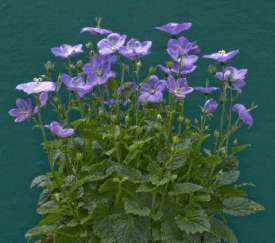
Use
This is one of the freest and most attractive of the large flowering dwarf Alpine Campanulas, very variable in seze and height, but all the forms are first rate.106)
Campanula turbinata Schott, Nym. et Kotschy, culture et multiplication du Campanula carpatica.107).
Besonders beliebt als Ziergewachs. 108)
Undersized and dwarf types. Dwarf types of wind chimes require a sunny location with nesyroy, light soil containing lime and enough humus. In autumn the plants pour sandy compost. At a suitable location can grow for years.109)
Le Campanula sono entrate nei giardini fino dalla seconda meta del xvi secolo, secondo le testmonianze di Gerard e di Clarici. Tra il 1596 e il 1597 Gerard raccolse in Inghilterra esemplari di Campanula persicaefolia, Campanula pyramidalis e Campanula medium che nella flora spontanea inglese non esistono: il che significa, dando tempo al tempo, che probabilmente in Italia erano state trasportate, dallaliberta dei campi al chiuso degli orti, forse parecchi decenni prima. Con certezza sappiamo che nei giardini francesi furonointrodotte nel 1774 la Campanula carpatica, nel 1779 la Campanula alpina e la Campanula pulla, nel 1783 la Campanula sibirica, nel 1788 la Campanula versicolor e la Campanula mollis; in Inghilterra nel 1774 la Campanula carpatica, nel 1775 la Campanula thyrsoides e nel 1779 la Campanula pulla.110)
Come si coltiva. La Campanula non e generalmente un fiore difficile da coltivare. Essendo originaria delle zone temperate dell'emisfero boreale, dove cresce su terreni freschi o umidi di regioni in prevalenza montane, richiede, oltre a un'esposizione luminosa e non troppo soleggiata, le stesse condizioni ambientali: il terreno, fatta eccezione per qualche specie, deve contenere una certa percentuale di calcio. Questo non significa che le Campanula non si possano coltivare magnificamente anche su un terrazzo assolatissimo. Per esperienza personale posso assicurare che la Campanula pyramidalis, la Campanula isophylla, la Campanula glomerata, la Campanula garganica, la Campanula carpatica, la Campanula fragilis e la Campanula persicaefolia, per limitarsi a poche, prosperano ottimamente sul terrazzo sotto un sole cocente, purche generosamente annaffiate. La Campanula carpatica e la Campanula garganica possono essere coltivate bene anche in vasi di cm. 16-18 di diametro, mentre la Campanula pyramidalis vuole uno spazio maggiore (cm 30) e la Campanula glomerata una misura intermedia. 111)
Velky péstitelsky zájem podminuje jednak bohatost kvétu a délka kvetení jako je tómu u druhu z príbuzenského orkruhu C. garganica nebo nápadné velikost kvétu napr. C. formanekiana, C. carpatica apod.112)
Mezi zvonky jsou druhy, které musíme hlídat, aby se jejich semens nevysela po skalce, pak se stávají nezádoucím plevelem. Jsou to napr. C. persicifolia, C. rotundifolia a v mensí míre i C. carpatica. Velmi obtízny plevel, zvlásté v teplejsích oblastech, je zvonek repkovity / C. rapunculoides /. Nékdy musime omezit i C. cochlearifolia nebo C. poscharskyana, které se prílis rozrústajif podzemními vybézky.113)
Velkou vyhodou zvonkú je, ze se nesnadno krizí a nemusíme mít ani u velkych sbírek obavy ze samovolné nezádoucí hybridisace, jako je tomu u mnoha junych rodú. Múzeme proto bez obav sbírat semena ze zahradních rostlin pro vlastní potrebu i pro vymény semen. Je vsak nutno dbát na správnou determinaci, protoze se prílis casto ve sbírkách vyskytují rostliny spatné urcené. Neznamená to, ze by byla hybridisace vyloucena. Velmi vzácné k ní dochází v prírodé, rovnéz umélym sprasováním vzniklo nékolik krízencú, které nasly své místo na skalkách a ve sbírkách péstitelú, které nasly své místo na skalkách a ve sbírkách péstitelú. Jsou t napr. C. x pseudoraineri = C. carpatica x C. raineri, C. x pulloides = C. carpatica var. turbinata x C. pulla habituelné pripomínající C. pulla, kdezto C. x wilsonii syn. 'G.F. Wilson' je hybrid stejnych rodicú, ale habituelné pripomíná více C. carpatica var. turbinata, C. x warleyensis = C. carpatica x C. cochlearifoli a casto se péstuje v plnokvété form. C. x kewensis = C. excis x C. arvatica, C. x wockei = C. waldsteiniana x C. tommasiniana. Starsí literatura uvádí jesté celou radu krízencú, my jsme je vsak nikdy nepéstovali, ani jsme se s nimi nikde ve sbírkách nesetkali.114)

